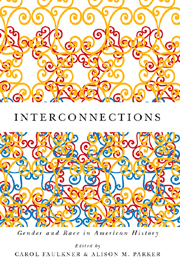Book contents
- Frontmatter
- Contents
- Introduction
- Part 1 Bridging History, Theory, and Practice
- Part 2 Frontiers of Citizenship
- Part 3 Civil Rights and the Law
- Part 4 Sexuality, Class, and Morality
- 7 A “Corrupting Influence”: Idleness and Sexuality during the Great Depression
- 8 What Women Want: The Paradoxes of Postmodernity as Seen through Promise Keeper and Million Man March Women
- Epilogue: Gender and Race as Cultural Barriers to Black Women in Politics
- Selected Bibliography
- List of Contributors
- Index
8 - What Women Want: The Paradoxes of Postmodernity as Seen through Promise Keeper and Million Man March Women
from Part 4 - Sexuality, Class, and Morality
Published online by Cambridge University Press: 05 December 2015
- Frontmatter
- Contents
- Introduction
- Part 1 Bridging History, Theory, and Practice
- Part 2 Frontiers of Citizenship
- Part 3 Civil Rights and the Law
- Part 4 Sexuality, Class, and Morality
- 7 A “Corrupting Influence”: Idleness and Sexuality during the Great Depression
- 8 What Women Want: The Paradoxes of Postmodernity as Seen through Promise Keeper and Million Man March Women
- Epilogue: Gender and Race as Cultural Barriers to Black Women in Politics
- Selected Bibliography
- List of Contributors
- Index
Summary
On the morning of October 4, 1997, members of the National Organization of Women (NOW) greeted the hundreds of thousands of Promise Keepers (PK) who gathered for the Stand in the Gap assembly on the National Mall with shouts of “Ominous!” and “Dangerous!” and with placards that read “Patriarch Keeper.” It was a familiar sight, one that had been repeated at almost every Promise Keepers gathering since Bill McCartney founded the organization in 1990, and one that would be repeated at every Promise Keepers gathering through the remainder of the 1990s. “They're a very sexist, racist and homophobic organization,” said Sondra Sinke, the Nebraska chapter coordinator of the National Organization for Women, when the Promise Keepers gathered in Omaha in 1999. Later that year, at the PK meeting in Hartford, Connecticut, the protest was the same. In an editorial titled “Much to Fear from Promise Keepers,” Alice Lambert, the president of the Connecticut NOW, wrote, among other things, “We feminists believe that women control their own bodies and lives. Bill McCartney …opposes women' rights.”
Feminist opposition to the Million Man March (MMM) was similarly insistent. Julianne Malveaux, the future president of Bennett College, asked, “When men are ‘stepping up,’ we have to ask, will the first step be onto a woman's back?“ Another black woman, Rhonda Williams, could also not support the march: “If it means that more men are capitulating to a type of thinking that says black families are simply broken and pathological, unaffected by economic and cultural change, and simply needing some more good ole-fashioned male supremacy—I can't sign on.”
- Type
- Chapter
- Information
- InterconnectionsGender and Race in American History, pp. 229 - 259Publisher: Boydell & BrewerPrint publication year: 2012



